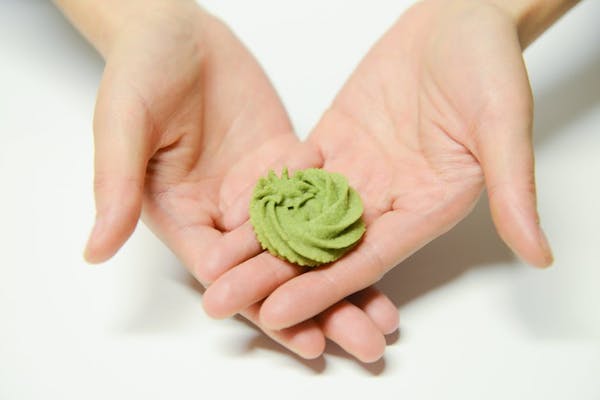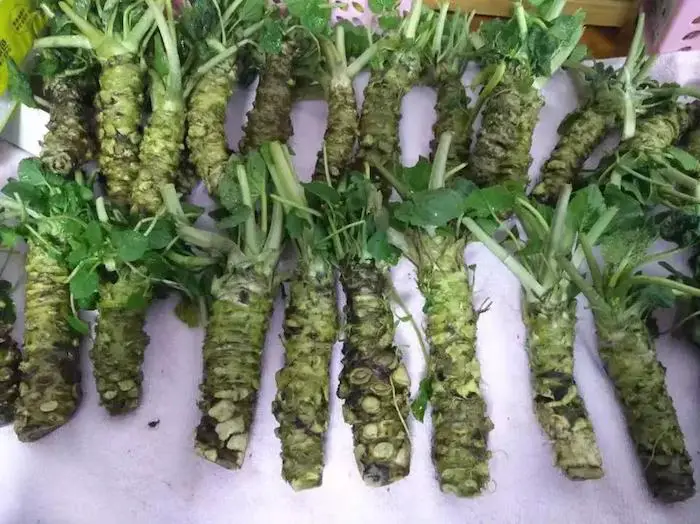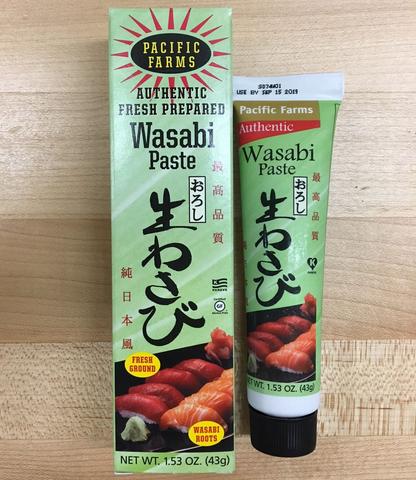We are reader supported. When you purchase through links on our site, we may earn an affiliate commission. Also, as an Amazon affiliate, we earn from qualifying purchases.

When you order sushi in a traditional Japanese restaurant, they will serve you rolls and nigiri with soy sauce and a spicy green paste. As you take a bite of the green thing, you can feel a zing whirl up to your nose and rock your inner system. Ever wondered why your body reacts so strangely to this plant-based food? Let’s find out.
What is wasabi made of? Real wasabi paste is prepared by grating the rhizome of a plant belonging to the Brassicaceae family. It contains a chemical substance called allyl isothiocyanate that can make your sinuses go wild. The fake wasabi substitutes are made by mixing horseradish, cornstarch, mustard flour, and green food colorant.
The physical traits of a wasabi plant are similar to cabbage and it is often called Japanese horseradish due to the similarity in appearance and taste. When real wasabi is grated, it releases volatile compounds that lend a distinguished taste to the condiment.
However, if left outside for a long time, the wasabi paste can lose its intensity as the compounds break down gradually. As a result, the wasabi paste tastes best when it’s consumed immediately after being grated.
Contents
Wasabi: A Rare And Expensive Plant

The wasabi plant is difficult to grow as requires natural shade and lots of cool running water. It thrives in the natural habitats of mountain river valley areas in Japan. Due to restrictions in the mass cultivation of wasabi plant, it is not readily available everywhere. As a result, many restaurants use Western Horseradish as a substitute.
If you are a sushi fan and eat out often, you will know that this green paste has a hot kick that complements vinegared rice and raw fish. I have done in-depth research on the topic to bring you the detailed information in this article- Do You Put Wasabi On Sushi.
While the real wasabi is the raw grated form of the stem, the fake wasabi found in restaurants is prepared by mixing several ingredients to get a similar taste. Most people who believe they know what wasabi is have actually never tasted the real thing.
Green Paste That They Call ‘Wasabi’

Most of the restaurants in the US and also in Japan serve a green paste they call ‘wasabi’ but it is actually not made from the real stem. A small bite of the real thing can blow your hair and make your sinuses go whacky but it does not leave a stingy aftertaste like the fake paste.
The substitute green paste they call ‘wasabi’ actually comes from the Horseradish plant (Armoracia rusticana). While it belongs to the same Brassicaceae family with cousins like broccoli, cauliflower, mustard, radish, and watercress, it also contains several unique characteristics.
If the green condiment served in a sushi restaurant sets your tongue ablaze and makes you swear never to try it again, you know what is wasabi made of in this case. It is definitely not the original thing!
Despite the same fiery personality, the real wasabi stem and horseradish have a lot of differences that are evident to those who have seen and tasted the real thing before. Let’s take a quick look at the differences.
| Characterstics | Real Wasabi | Fake Wasabi |
| Growing conditions | Grows in stream beds and river valleys in Japan and selected locations in the US | Grows in the ground, in all parts of the world |
| What is consumed | Rhizome, leaves, and stems | Roots and leaves |
| Method of preparation | Grating | Grating |
| Peeling texture | Bumpy | Smooth |
| Skin color | Medium green | Light brown |
| Color without skin | Pale green | White |
| Leaf color | Deep green | Medium green |
| Leaf shape | Heart shaped | Chard shaped |
| Taste | Pungent, not spicy and accentuates the flavor of raw fish | Extremely spicy that tends to override the delicate flavor of raw fish |
Growing Wasabi In Your Own Backyard
Given the fact that real wasabi is so rare and expensive, some sushi traditionalists hope to grow their own wasabi plant at home? But, is it really possible to grow the plant in the home garden? Let’s find out. According to researchers, wasabi plants thrive well when left undisturbed in the mountain stream beds.
The favorable climate includes an air temperature between 8 degrees and 20 degrees Celsius, with high humidity levels in the summer season. The plant cannot stand direct sunlight and requires a shaded area to thrive.
Due to the specific growing requirements, there are very limited locations in the US where wasabi grows naturally. Few areas in the Pacific Northwest states have proved to have suitable conditions for its growth. North Carolina’s mountainous regions have also been considered as favorable.
This is an extremely slow growing plant that can take up to 3 years to mature. When favorable conditions are provided, the stems of the plant can grow to a length of 12 to 18 inches. When the plant reaches up to 2 feet in width and height, it enters the next phase when the rhizome starts producing the unique flavors and nutrients it is known for.
You may grow wasabi in a garden or backyard if you are lucky enough to live close to a mountain stream with abundant shade. However, bear in mind that when growing outside, the plants may get different types of disease that can hamper their growth and ruin your efforts.
If you are enthusiastic about growing wasabi on your own, I would suggest that you get one of the seedling boxes and take good care of the plant. The seedling boxes thrive well in an unheated greenhouse and they must be watered daily to ensure that the seeds stay moist.
Wasabi plants are intolerant to sunlight, so protect them with the help of a black shade cloth. You may invest in a micro-irrigation system in your backyard to keep the soil moist at all times.
These plants need free-flowing water and the micro-immigration system closely imitates the natural river streams. If you plant the seeds in September to October, they will start germinating before winter commences.
3 Tips For Choosing Wasabi Wisely
- If growing your own wasabi at home sounds like too much work and risk, I suggest that you purchase online from companies that grow organic, certified and mountain-grown wasabi. When selecting the roots, always pick the ones that look fresh and unshrivelled.
- The same rule applies for choosing wasabi leaves that are often used in making delicious green salad. The leaves should not be soggy and they must have uniform green color. To store the rhizome, wrap it in a moist towel and keep inside the refrigerator.
- I suggest rinsing the stem with cold water every alternate day and cut out the spoiled parts to retain its freshness. When stored properly, the wasabi can last for up to one month.
Real Wasabi Comes In 3 Different Formats
If you choose to buy wasabi online, you will find them in three basic formats. The price also varies, so check them out and buy the one that suits your needs.
#1. Wasabi paste

In this type, wasabi comes in paste format filled inside a squeeze tube. It comes handy when you suddenly decide to have a sushi dinner and this readymade paste brings the perfect heat to your sushi meal. If you love sushi but don’t make it at home frequently, I would suggest you buy the paste.
While it is not as good as real wasabi made fresh from the stem, it is much superior to the fake thing. Once you open the tube, make sure you place the cap tightly after use and store the remaining paste inside the refrigerator.
#2. Powdered wasabi
The wasabi powder is cheaper than the paste and does not taste as good. However, it still gives you a more authentic flavor than fake wasabi served at restaurants. You will need to mix the powder with water whenever you are in the mood for cooking sushi at home.
The wasabi powder can also be used in a plethora of other Japanese dishes. So, if you have a fetish for that ‘heat’ wasabi brings to the food, considered buying the powdered wasabi.
#3. Wasabi rhizome
The real rhizome or stem is rare to find but if you find a seller who gives you authentic wasabi root, consider yourself lucky. You will need to grate the rhizome using a sharkskin grater to get that perfect consistency. I have created an unbiased review for shark skin grater to help you choose wisely.
If you don’t find them in the physical stores, check out some of the online stores that sell real wasabi roots. Store the rhizome well wrapped in a damp cloth inside a refrigerator once you get home or have it delivered to you.
The grated wasabi paste has the characteristic to lose its flavor after a few minutes, so make sure you prepare it right before your meals and consume immediately. If you leave it in the open, it will lose all the zing that gives you that kick.
Preparing Wasabi Paste At Home
To prepare your own wasabi paste at home, peel the stem with a sharp Japanese knife. Now, take a sharkskin grater and move the stem in circular motions. The grating motion activates the compounds inside the wasabi and turns them volatile, resulting in that characteristic punch. I have created an article that explains in detail – how to make real wasabi paste at home.
Besides using the green wasabi paste as a condiment with your sushi meal, you may also add them to your noodle soups, grilled meats, marinades, dips and a variety of salad dressings. If a restaurant at all uses the real wasabi, the chef typically puts a smear of it inside the roll or beneath the fish slice in a nigiri.
Fake Wasabi Rules The Market, Unfortunately!
It’s an unfortunate fact that real wasabi still eludes many fans of this green spicy condiment. The fake stuff rules the market and you can find the green colored horseradish paste everywhere, in the stores, sushi restaurants, and online marketplace.
What is even more perplexing is that storekeepers, manufacturers and restaurant owners get away with lying about what they actually sell or serve. No doubt the ingredients are mentioned somewhere in the packet in small prints. However, this cannot compensate for the fact that they call it wasabi when it is actually not. In some cases, the fake wasabi does not even resemble the real thing.
I am sure most people will agree with me that there should be some law against selling fake wasabi as real. Until that happens, you can rely on your tastebuds and gut feeling to know what is real wasabi and what is not. Next time, your mouth goes ablaze after eating the green paste, you know it should not be like that.
Real wasabi derived from the Wasabia japonica plant has complex flavors and produces a mild heat that will give you a punch but not leave you with a burning sensation. According to Doug Lambrecht, the owner of an American company that grows organic wasabi, the original stem has a versatile and fuller flavor that complements several dishes. The heat usually disappears after some time leaving behind a sweet taste in the mouth.
A Peek Into The History Of This Ancient Condiment
Since no one knows when wasabi plants continue to grow along the river banks and streams in the mountainous areas of Japan. There’s no specific record on how this spicy condiment became such an integral part of the local cuisine.
As per the archaeological facts mentioned in Tokyo Foundation, it reveals that wasabi finds mention in the Jomon Period. It shows that this spicy condiment was deeply rooted in the ancient Japanese civilization.
As sushi made with raw fish gained popularity in Japan, wasabi became a much sought after condiment and the plants was heavily cultivated across the favorable regions. What originally started as a tradition to preserve fish in fermented rice soon turned into a delicacy made of vinegared rice and fish.
It was later discovered that adding wasabi as a side condiment helped in improving the flavor and aroma of raw fish. The antioxidant and antibacterial properties of wasabi also reduce the risk of getting sick due to food poisoning from eating raw fish.
Wasabi Gains Status Of Asian Superfood
The recent development in lab testing of wasabi rhizome has confirmed that it can be designated as an Asian superfood for a healthy life. According to health experts, wasabi is not only rich in vital nutrients like vitamin C and calcium but also has specific medicinal properties. It is known to have potential therapeutic values such as antiplatelet, anti-inflammatory, and anti-cancer.
Much of the health benefits associated with wasabi is due to a chemical called the 6-Methylsulfinylhexyl isothiocyanate. It is similar to the sulfur-like compounds present in plants belonging to the mustard family. More than its health benefits, wasabi is sought after for its incredible taste.
Future of Wasabi In Global Culinary Scene
With the wide ranging popularity of sushi and its condiments, Japanese traditions and culture have also become a global phenomenon. The powerful wasabi root has become one of the most sought after condiments in the world.
You can find wasabi in different formats as mentioned above and it can help you add a zing to your dishes. And, if the green sauce leaves your mouth burning, you know that is not real wasabi.
Besides sushi, pizzas, and stews, the wasabi paste also serves as a great base for meat and fish sauces. Interestingly, the green root has also found its own ice-cream flavour. What else can you ask for?
Related Questions
How can you describe the hotness of wasabi?
The hotness is similar to the flavor or horseradish or hot mustard than chili pepper. It blows a punch to the nose instead of the tongue. Now that you have come close to the end of this article, at least you know what is wasabi made of.
Why is wasabi green colored
The fake wasabi is made from horseradish which is bone white in color. However, the real wasabi paste is made by grating the rhizome of a wasabi plant and it is green in color. This natural green color comes from the presence of chlorophyll that you find in green vegetables.
Is wasabi a root or stem?
It is a stem that is grated to form the wasabi paste. Most people often confuse it as root but it is not so. The term ‘rhizome’ is often used because it means stem forms when the leaves die back.
Is wasabi more hotter than horseradish
People think wasabi has a higher intensity of heat than horseradish because of the substitutes they have consumed in sushi restaurants. The fake wasabi paste has mustard added for that extra pungency but the real thing is not that hot. It is fragrant and does not leave a burning sensation in the mouth.
Why is wasabi considered good for sinuses
As you eat wasabi, the vapors emitting from the allyl isothiocyanate compound travels from the back of the mouth to the nasal cavity. It can make your sinuses go wild and clear congested nose. As a result, some people eat wasabi when they are struggling with an allergy to get relief.
See Also:
Is Sushi Good For A First Date?
What Is Chirashi (Sushi)?
15 Reasons To Eat Sushi: Why Is Good For You


